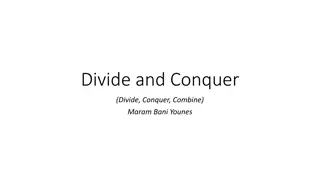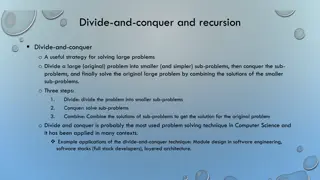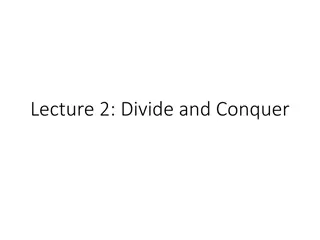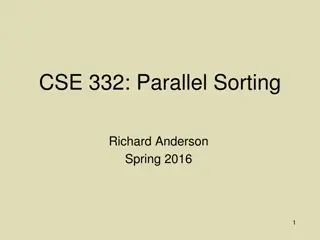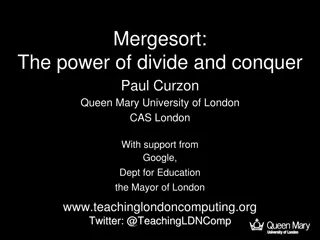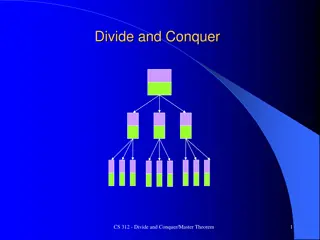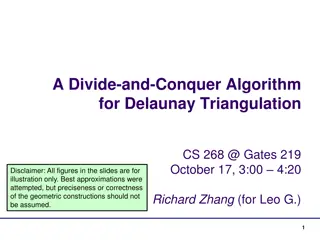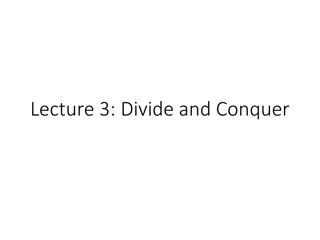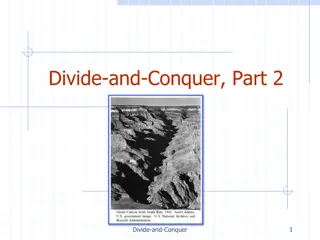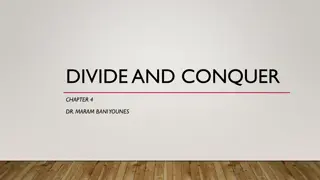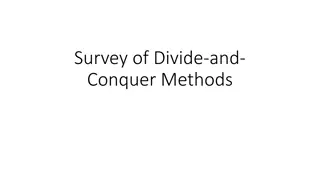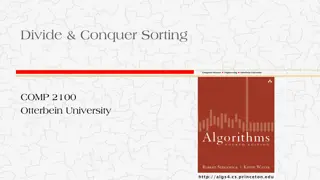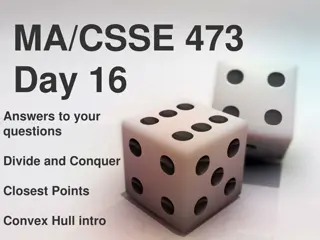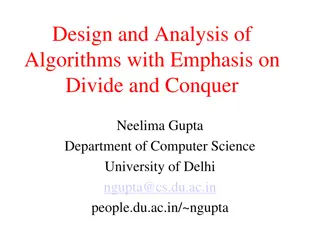Understanding Divide and Conquer Algorithms for Big Data
Divide and Conquer Algorithms are a powerful paradigm in computer science where a problem is broken down into smaller parts, solved individually, and then combined to solve the original problem. This approach is exemplified in concepts like fast multiplication algorithms and finding the kth element in a sorted array. By efficiently dividing tasks and leveraging small solutions to solve complex problems, Divide and Conquer Algorithms play a crucial role in handling big data effectively.
Download Presentation

Please find below an Image/Link to download the presentation.
The content on the website is provided AS IS for your information and personal use only. It may not be sold, licensed, or shared on other websites without obtaining consent from the author. Download presentation by click this link. If you encounter any issues during the download, it is possible that the publisher has removed the file from their server.
E N D
Presentation Transcript
CMPT 706 - Algorithms for Big Data Divide and Conquer Algorithms February 6, 2020 Divide and Conquer 1-1
Divide and Conquer Algorithms Divide and Conquer 1-2
Divide and Conquer Algorithms Divide and Conquer Algorithms are a general paradigm: Given an input we break it into smaller parts (divide) Solve each part separately (conquer) Use the small solutions in order to solve the original (bigger) problem (combine) Example: Fast multiplication algorithm we saw Given two n-bit numbers, we solved 3 sub-problems each on n/2 bit, and used these to multiply the inputs. Runtime: Master Method allows us to analyze the runtime. Divide and Conquer Algorithms 1-3
Finding Median Divide and Conquer 1-4
Finding Median Input: an array of n integers Goal: Find the n/2-nd element in the increasing order. More general goal: Given an integer k, find the k element in the increasing order. A na ve idea : Given an array: sort it and return the element in position k. Runtime: O(n log(n)) Can we do better? Divide and Conquer Algorithms 1-5
Finding kth element in the increasing order Input: an array A of n integers Goal: Given an integer k, find the k element in the increasing order. Idea: Given an array A Choose some pivot a random element from A Rearrange all elements of A into two subarrays A pivot all elements pivot. A>pivot all elements > pivot. If A pivot has more than k elements, continue the search in A pivot . Otherwise, continue the search in A>pivot . Continue the search until A has 1 or 2 elements. Divide and Conquer Algorithms 1-6
Finding kth element in the increasing order Example: A = [1,5,3,7,2,6,3,9,4,8] and k=5. Choose pivot = 6. Rearrange all elements of A into two subarrays A pivot = [1,5,3,2,6,3,4] A>pivot = [7,9,8] A pivot has 7 elements. 7>k, hence we should continue to A pivot. --------------------------------------------- Our new A = [1,5,3,2,6,3,4], k=5. Let pivot =2 A pivot = [1,2] A>pivot = [5,3,6,3,4] A pivot has 2 elements. 2<k hence we continue in A>pivot with new k=5-2=3. -------------------------------------------- A = [5,3,6,3,4], k=3 Return 4 Divide and Conquer Algorithms 1-7
Finding kth element in the increasing order Runtime: In general the runtime depends on the choice of pivots. Let A0 = A be the original array. Let A1 be the array after 1 iteration, and suppose that it contains n1 elements Let A2 be the array after 2 iterations , and suppose that it contains n2 elements .. Let Ai be the array after i iterations , and suppose that it contains ni elements Optimistic view: Suppose that ni < ni-1/2 in each step Then T(n) < T(n/2) + Cn. By applying recursion we get T(n) < T(n/2) + Cn < T(n/4) + C(n/2) + C(n) < T(n/8) + C(n/4) + C(n/2) + C(n) Then T(n) = T(n1) + O(n) T(n1) = T(n2) + O(n1) T(ni-1) = T(ni) + O(ni-1) Divide and Conquer Algorithms = C(1 + 2 + 4 + n/4 + n/2 + n) < 2Cn = (n) 1-8
Finding kth element in the increasing order Runtime: In general the runtime depends on the choice of pivots. Let A0 = A be the original array. Let A1 be the array after 1 iteration, and suppose that it contains n1 elements Let A2 be the array after 2 iterations , and suppose that it contains n2 elements .. Let Ai be the array after i iterations , and suppose that it contains ni elements Pessimistic view: What if ni = ni-1-1 in each step Then T(n) = T(n-1) + Cn. By applying recursion we get T(n) < T(n-1) + Cn < T(n-2) + C(n-1) + C(n) < T(n-3) + C(n-2) + C(n-1) + C(n) = C(1 + 2 + 3 + 4 + + n-1 + n) = (n2) Then T(n) = T(n1) + O(n) T(n1) = T(n2) + O(n1) T(ni-1) = T(ni) + O(ni-1) Divide and Conquer Algorithms 1-9
Finding kth element in the increasing order Question: How should we choose a pivot so that in each step the number of elements decreases by some constant factor? Exercise: Prove the if ni < (2/3)*ni-1 in each step, then we are still in the Optimistic view, i.e. T(n) < T(0.9n) + Cn implies that T(n)=O(n) Does it work? Ideas how to choose a pivot: Should work with high probability 1. Choose a random element in the array 2. Choose 3 random elements in the array, and let pivot be their median 3. Choose 7 random elements in the array, and let pivot be their median 4. Choose n random elements in the array, and let pivot be their median But how? Use sorting algorithm on the n elements it takes < n steps. Divide and Conquer Algorithms 1-10
Analyzing Median find for random pivod Choosing a pivot: Given an array of n elements choose n random elements in the array Let pivot be their median Claim: Pr[pivot removes at least n/3 element] > 1 - e-c n for some constant c. In simple words, is n is large, then with probability 0.9999 the pivot will remove at least n/3 elements. Divide and Conquer Algorithms 1-11
Algorithms for Big Data Median Deviation Let ? denote the median of the list ?1, ,?? median of sample sample 1 ? 1 2 ? ? 1 2+ ? ? median Let X be the number of sampled elements above 2n/3. In expectation only k/3 of the elements should be above 2n/3. Failure: X > k/2 Then Pr[X > k/2] < , where =1/e (k) 7-12
Chernoff bound Theorem [Chernoff bound]: Suppose ?1,?2, ?? are independent 0-1 random variables, such that Pr ??= 1 = ?. Let ? = ?1+ ?2+ + ?? . Then Pr ? ?? > ??? < 2 ? ?2??/3. Intuition: Sum of independent 0-1 random variables is tightly centered on the mean. Question: if you toss a fair coin k= 1000 times, what is the probability that the number of heads is between 333 and 666? ?1, ?? - independent 0-1 random variables, such that Pr ??= 1 = 1/2. What is the probability that 2?/3 ?1+ ?2+ + ?? ?/3? By Chernoff bound: Let ? = 1/2,? = 1/3. Pr |?1+ ?2+ + ?? ?/2| > ?/6 < 2 ? ?/54. Answer: The probability is at least 1-2e-1000/54>0.99999. Divide and Conquer Algorithms 1-13
Chernoff bound Ex: Prove that Pr[median of ai s is in the top third]<2e-k/36 Theorem [Chernoff bound]: Suppose ?1,?2, ?? are independent 0-1 random variables, such that Pr ??= 1 = ?. Let ? = ?1+ ?2+ + ?? . Then Pr ? ?? > ??? < 2 ? ?2??/3. Back to our median find algorithm: Given an array of length n, we choose k= n random elements in the array a1, ak. What is the probability that the median of a1, ak is in the bottom third of the array? ?1, ?? - independent 0-1 random variables indicating if ai is in the bottom third. We have Pr ??= 1 = 1/3. Then Pr ?????? ?? ?? By Chernoff bound: Let ? = 1/3,? = 1/2. Pr ?1+ ?2+ + ?? ?/2 Pr |?1+ ?2+ + ?? ?/3| > ?/6 < 2 ? ?/36. ? ?? ?? ? ? ?????? ? ??? = Pr[?1+ ?2+ + ?? ?/2] Divide and Conquer Algorithms 1-14
Chernoff bound Back to our median find algorithm: Given an array of length n, we choose k= n random elements in the array a1, ak. What is the probability that the median of a1, ak is in the bottom third of the array? ? ?? ?? ? ? ?????? ? ??? < 2? ?/36 ? ?? ?? ? ? ??? ? ??? < 2? ?/36 Pr ?????? ?? ?? Pr ?????? ?? ?? Therefore, probability of failure is at most 4 ? ?/36. That is, pivot does not reduce the size by at least n/3 is at most 4 ? ?/36. Divide and Conquer Algorithms 1-15
Quick Sort Divide and Conquer 1-16
Quick Sort Input: an array of n integers Goal: sort its elements in the non-decreasing order. Assumption: each element is short. oEach element can be read in O(1) time, oCan compare two elements in O(1) time Quick sort algorithm: it is a divide and conquer algorithm Given an array A[1 n] Choose a pivot p Rearrange all ai < p are to the left of p, and all ai >= p are to the right of p. Sort the elements that are <p (using recursion) Sort the elements that are >=p (using recursion) Divide and Conquer Algorithms 1-17
Quick Sort Example: Input: [4, 1, 8, 7, 10, 3] Let pivot =7 Rearrange to get [4,1,3] and [7, 10, 8] Sort [4, 1, 3] [1, 3, 4] Sort [7, 10, 8] [7, 8, 10] Correctness: it is clear: If each of the two halves is sorted, the it suffices to push the elements from right to left to their correct position. Divide and Conquer Algorithms 1-18
Quick Sort Runtime: Denote the runtime on array of length n by T(n). Rearranging takes O(n) time Then we need to sort each of the two parts separately. Suppose one part has 2n/3 elements and the other n/3 in each step. Q: How can we choose such a pivot? A: Choose random elements, and find a median among them T(n) = O(n) + T(n/3) + T(2n/3). What is the runtime here? By Master Method: T(n) < 2T(2n/3) + O(n). a = 2, b = 3/2, d=1 logb(a) = log1.5(2) = 1.709 Therefore, T(n)= O(n1.709). A more careful analysis gives O(n log(n)) Divide and Conquer Algorithms 1-19
Finding median deterministically Q: Can we find the k th element of an array using a deterministic algorithm? Q: Can we get rid of randomness? Divide and Conquer Algorithms 1-20
Finding the kth element deterministically Idea: Given an array A of length n, and an integer k Partition A into n/5 arrays each of size 5 Let B = [b1 bn/5] be the medians of each of the sub arrays. Let pivot be the median of B = [b1 bn/5] can be computed using recursion Let pivot be the median of B Rearrange all elements of A into two subarrays A pivot all elements pivot. A>pivot all elements > pivot. If A pivot has more than k elements, continue the search in A pivot. Otherwise, continue the search in A>pivot. Correctness: Obvious. Divide and Conquer Algorithms 1-21
Finding the kth element deterministically Idea: Given an array A of length n, and an integer k Partition A into n/5 arrays each of size 5 Let B = [b1 bn/5] be the medians of each of the sub arrays. Let pivot be the median of B = [b1 bn/5] can be computed using recursion Rearrange all elements of A into two subarrays A pivot all elements pivot. A>pivot all elements > pivot. If A pivot has more than k elements, continue the search in A pivot. Otherwise, continue the search in A>pivot. Ex: Prove that T(n) = O(n). Runtime: T(n) <= T(n/5) + T(7n/10) + O(n) -- why? Because there are: (1) at least 3n/10 elements >= pivot and (2) at least 3n/10 elements <= pivot Divide and Conquer Algorithms 1-22
Matrix Multiplication Divide and Conquer 1-23
Matrix Multiplication Product of two nxn matrices X and Y is defined as ?11 ??1 ??1 ?1? ??? ??? ?1? ??? ??? ?11 ??1 ??1 ?1? ??? ??? ?1? ??? ??? ??1 ?1?+ + ??? ??? = Naively, computing each entry in the product takes (n) operations. There are n2 entries in the result. Therefore, the total runtime is (n3) Can we do better? Divide and Conquer Algorithms 1-24
Strassens Algorithm Product of two 2x2 matrices is defined as ? ? ? ?? + ?? ?? + ?? ?? + ? ?? + ? ? ? ? ? = That s a total of 8 multiplications ( + 4 additions) We can also write ? ? ? ?5+ ?4 ?2+ ?6 ?3+ ?4 ?1+ ?2 ? ? ? ? = ?1+ ?5 ?3 ?7 where ?1= ?(? ) ?3= ? + ? ? ?5= ? + ? ? + ?7= ? ? ? + ? That s only 7 multiplications! ?2= ? + ? ?4= ? ? ? ?6= ? ? ? + Can we use it to multiply nxn matrices faster? Divide and Conquer Algorithms 1-25
Strassens Algorithm Let ?11 ??1 ?1? ??? ?11 ??1 ?1? ??? ? ? ? ?, ? = ? ? ? ? ? = = = Define the product ?? recursively ? ? ? ? ?5+ ?4 ?2+ ?6 ?3+ ?4 ?1+ ?2 ? ? ? ? = ?1+ ?5 ?3 ?7 Running time ?(?)=7?(?/2)+?(?2) By the Master Theorem ?(?)=?(?log2(7)) ?(?2.81) Best result: Le Gall (2014) ?(?2.3728639) Divide and Conquer Algorithms 1-26
Homework and Reading for next time Exercises from the Book: 2.15, 2.17, 2.22, 2.24, 2.27, 2.28 Reading 3.1, 3.2, 3.3, 3.4 Divide and Conquer Algorithms 1-27




